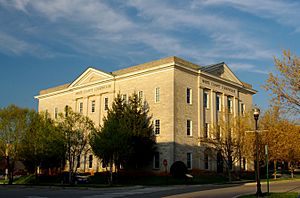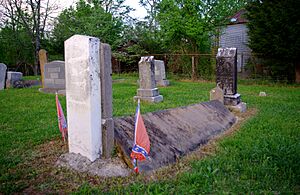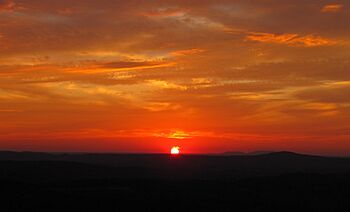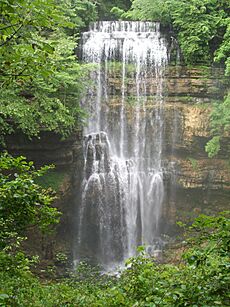White County, Tennessee facts for kids
Quick facts for kids
White County
|
|||
|---|---|---|---|

White County Courthouse in Sparta
|
|||
|
|||

Location within the U.S. state of Tennessee
|
|||
 Tennessee's location within the U.S. |
|||
| Country | |||
| State | |||
| Founded | September 11, 1806 | ||
| Named for | John White, early settler | ||
| Seat | Sparta | ||
| Largest city | Sparta | ||
| Area | |||
| • Total | 379 sq mi (980 km2) | ||
| • Land | 377 sq mi (980 km2) | ||
| • Water | 2.8 sq mi (7 km2) 0.7%% | ||
| Population
(2020)
|
|||
| • Total | 27,351 |
||
| • Density | 69/sq mi (27/km2) | ||
| Time zone | UTC−6 (Central) | ||
| • Summer (DST) | UTC−5 (CDT) | ||
| Congressional district | 6th | ||
White County is a county located in the state of Tennessee, USA. In 2020, about 27,351 people lived there. The main town and county seat (where the county government is) is Sparta. White County is also part of the larger Cookeville Micropolitan Statistical Area.
Contents
Exploring White County's Past
On September 11, 1806, White County was officially created by the Tennessee General Assembly. It was formed from parts of Smith and Jackson counties. At first, White County was much larger than it is today. It included all of what are now White and Warren counties, plus parts of several other modern counties.
How White County Got Its Name
There's a bit of a mystery about how White County got its name. Officially, it's named after John White (1751–1846). He was a soldier in the American Revolutionary War, a surveyor, and one of the first known white settlers in the area. John White moved his family from Virginia to the Cumberland Mountains in 1789. However, some historians think the county might have been named after another Revolutionary War soldier, James White, who founded the city of Knoxville.
Early Settlements and Sparta
The first temporary county seat was set up near Rock Island. This area is now in Warren County. Three years later, a permanent county seat was chosen. It was built on the banks of the Calfkiller River and named Sparta.

Health Resorts and Saltpeter Mining
In 1840, White County became a popular place for visitors. Christopher Haufmann built a large hotel on Bon Air Mountain, which is part of the Cumberland Plateau. The hotel was close to mineral springs and was at a high elevation. People believed these things were good for health, so they came from all over for the "cures" offered by the resort.
During the American Civil War, White County was a major site for saltpeter mining. Saltpeter is the main ingredient used to make gunpowder. The Cave Hill Saltpeter Pits were heavily mined, and you can still find relics from those operations today.
The Civil War's Impact
The Civil War greatly affected White County, even though no big battles happened there. Because it was between the pro-Union East Tennessee and the pro-Confederate Middle Tennessee, the county saw a lot of fighting. This fighting was often from "bushwhackers," who were partisans (fighters not part of a regular army) from both sides.
One famous Confederate guerrilla (a fighter using surprise attacks) in the area was Champ Ferguson. He caused a lot of trouble and destruction. He was arrested after the war in 1865, tried by a military court, and executed by hanging. He is buried in France Cemetery near Sparta.
Rebuilding and Coal Mining
After the war, White County slowly recovered. The county became connected to the outside world by railroad. This was mainly because of the growing coal mining businesses on Bon Air Mountain. The mountain had a lot of bituminous coal, and local business people quickly saw how profitable it could be. Several mining towns grew up on the plateau, including Bon Air, Eastland, and Ravenscroft.
In 1981, a disagreement happened between a local mining company and residents. The mining companies started to strip mine on people's private land. This led to a case in the Tennessee Supreme Court called Doochin v. Rackley. The court decided that strip mining was not allowed under the old land deeds, protecting the residents' land.
White County's Natural Beauty
White County covers about 379 square miles. Most of this (377 square miles) is land, and a small part (2.8 square miles) is water. The eastern part of the county is on top of the Cumberland Plateau. The western part is on the Highland Rim, which is at a lower elevation. You can see the steep edge of the Plateau from many places in the western part of the county.
Rivers and Waterfalls
The Caney Fork is the county's main river. It flows through the southern part of the county and forms some of its border with Van Buren, Warren, and DeKalb counties. The river drops from the Cumberland Plateau into the Highland Rim through Scott's Gulf. This is a beautiful gorge known for its scenic waterfalls, like the 110-foot-tall Virgin Falls.
Part of the Caney Fork in southern White County is now part of Great Falls Lake. This is a lake created by the Great Falls Dam at Rock Island State Park. Downstream from this dam, the river flows into another lake called Center Hill Lake.
The Calfkiller River flows through the middle of White County. It is a branch of the Caney Fork and drains the county seat, Sparta. The Falling Water River also flows through the northwestern part of the county. It forms part of the border with Putnam County. The Falling Water River is famous for its 136-foot waterfall, Burgess Falls, which is right on the Putnam-White county line.
Caves and Natural Wonders
White County has more than 1,200 documented caves! That's over 3.17 caves per square mile, making it one of the most cave-filled regions in the world.
Blue Spring Cave
Blue Spring Cave, located five miles northeast of Sparta, is the longest mapped cave in Tennessee. It's also the tenth longest cave in the United States, with 38 miles of passages. In 1990, Bill Walter discovered the footprints of jaguars that lived during the Ice Age (Pleistocene period) in the cave.
Neighboring Counties
White County shares its borders with these counties:
- Putnam County (north)
- Cumberland County (east)
- Van Buren County (south)
- Warren County (southwest)
- DeKalb County (west)
Major Roads in White County
 US 70
US 70 US 70S
US 70S SR 1
SR 1 SR 84
SR 84 SR 111
SR 111 SR 135
SR 135 SR 136
SR 136 SR 285
SR 285 SR 289
SR 289
State Protected Areas
White County is home to parts of several beautiful state protected areas:
- Bledsoe State Forest
- Bridgestone/Firestone Centennial Wilderness Wildlife Management Area
- Burgess Falls State Park and Natural Area
- Rock Island State Park
- Sparta Rock House State Historic Site
- Virgin Falls State Natural Area
Population Over Time
| Historical population | |||
|---|---|---|---|
| Census | Pop. | %± | |
| 1810 | 4,028 | — | |
| 1820 | 8,701 | 116.0% | |
| 1830 | 9,967 | 14.6% | |
| 1840 | 10,747 | 7.8% | |
| 1850 | 11,444 | 6.5% | |
| 1860 | 9,381 | −18.0% | |
| 1870 | 9,375 | −0.1% | |
| 1880 | 11,176 | 19.2% | |
| 1890 | 12,348 | 10.5% | |
| 1900 | 14,157 | 14.7% | |
| 1910 | 15,420 | 8.9% | |
| 1920 | 15,701 | 1.8% | |
| 1930 | 15,543 | −1.0% | |
| 1940 | 15,983 | 2.8% | |
| 1950 | 16,204 | 1.4% | |
| 1960 | 15,577 | −3.9% | |
| 1970 | 17,088 | 9.7% | |
| 1980 | 19,567 | 14.5% | |
| 1990 | 20,090 | 2.7% | |
| 2000 | 23,102 | 15.0% | |
| 2010 | 25,841 | 11.9% | |
| 2020 | 27,351 | 5.8% | |
| U.S. Decennial Census 1790-1960 1900-1990 1990-2000 2010-2014 |
|||
As of the 2020 United States census, there were 27,351 people living in White County. There were 10,048 households and 6,904 families.
Learning in White County
White County has several public schools for students of all ages.
Public Schools
- White County High School
- White County Middle School
- BonDeCroft Elementary School
- Cassville Elementary School
- Central View Elementary School
- Doyle Elementary School
- Findlay Elementary School
- Northfield Elementary School
- Woodland Park Elementary School
Towns and Communities
White County has one city and one town, along with several smaller unincorporated communities.
City
Town
Unincorporated Communities
These are smaller communities that don't have their own local government:
Famous People from White County
Many notable individuals have connections to White County:
- David Culley – A coach in the National Football League.
- George Gibbs Dibrell – A U.S. Congressman and a Confederate general.
- Champ Ferguson – A Confederate guerrilla during the Civil War.
- Lester Flatt – A famous bluegrass guitarist and mandolin player, known for "The Foggy Mountain Boys."
- Kellie Harper – A successful women's basketball head coach for the University of Tennessee Lady Vols. She is a graduate of White County High School.
- Benny Martin – A bluegrass musician who invented the eight-string fiddle.
- Carl Rowan – A well-known journalist, author, and former U.S. Ambassador to Finland.
- Pauline Weaver – An Arizona mountain man (a frontiersman), born in White County.
- Earl Webb – A Major League Baseball player who holds the record for the most doubles in a single season.
See also
 In Spanish: Condado de White (Tennessee) para niños
In Spanish: Condado de White (Tennessee) para niños






